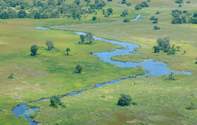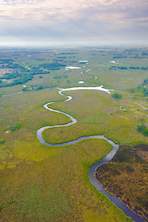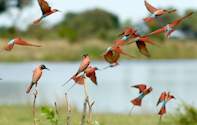
Water cannot flow backward, or uphill! noted the famous African missionary-explorer David Livingstone when he reached the enigmatic Okavango Delta in 1851, in the company of hunter-explorer Charles Andersson.
Livingstone had left his wife and children on the disease-ridden shores of Lake Ngami in order to go exploring. They contracted various tropical maladies and succumbed one by one but that is another story...
In truth, Livingstone was a complete failure as a missionary, but a great explorer who was loved, even worshipped, by the Africans with whom he came into contact. On the other hand he was an obsessively driven expedition leader who was frequently despised by his fellow explorers. He would deny them such expedition staples as jam, tea, sugar and alcohol (he was a teetotaler) and accuse them of many and varied wrongdoings (mostly unjustly).
But he was right about water flow, at least partly. Ever since Archimedes invented the water screw and the Romans built their aqueducts, people have known that open water can flow in only one direction and that is downhill.
However, when he reached the Okavango, the world's largest inland delta which reaches some 15,000 square kilometres at full flood, he noted how the waterways seemed to flow one way one season and another the next. Channels would flow strongly, stop, and sometimes even reverse direction. The system seemed to defy all human logic. It had perplexed the local tribesmen forever and everyone else for the following 150 years.
Defying Gravity

The Okavango River rises in the central Angolan highlands where it is swelled by thunderous summer rainstorms. From there, floodwaters take several months to reach Botswana. Once upon a time the Okavango was joined by the upper Zambezi River but over time the Okavango pursued its own course southwards to inland annihilation, first into the Delta and from there into the vast necklace of salt pans in central Ngamiland, Botswana's northern province.
The Okavango Delta has been described as a sea of land, a land of water. The fall of land from one end to the other, across some 300 kilometres, is a scant 45 metres. The Delta is a shifting tableau of reed-lined channels, swampy stagnant expanses, lediba or lagoons, forest-fringed islands and a bewildering network of interconnecting, fluctuating backwaters.
When Livingstone was up that way, the Selinda Spillway and Savuti Channel, sinuous watercourses that connect the Okavango to the Linyanti and Chobe wetland systems to the east, were flowing strongly. When hunter Frederick Courteney Selous passed by some decades later he found them dry. Decades later again they flowed, and then dried again, even reversing direction at times.
In the early 1970s they were flowing strongly, but dried up all through the 1980s and 90s. Then in early 2005 there was again a hint of liquid activity in their dust-dry beds, and therein was the clue to the mysterious hand that drove the system of waters that could flow this way or that, apparently quite randomly: The bedrock that lies beneath the deep lens of sand on which the Delta lies like a chimerical mirror, is criss-crossed with a fine network of faults, looking like a frayed rope-end at the southernmost limit of the Great Rift Valley.
The last shake-up occurred in 2004 soon after the most violent earthquake in modern times ripped apart an island in Indonesia and sent shock waves a.round the world. A ghost tremor of that cataclysm rippled along the east coast of Africa and down the Rift Valley. Those hairline cracks beneath Ngamiland quivered, the sand rippled and shifted, so subtly hardly anyone noticed.
The sand levees shook and shifted, almost imperceptibly. But just enough to tilt the land and allow a trickle, then the flood, to flow down the Thamalakane River and into the Botea, then onwards to swell Lake Ngami for the first time in decades. At the same time the Khwai channel flowed into the Selinda Spillway and the Linyanti into Lake Zibadianja and together they fed the Savuti Channel, which had not tasted the cooling waters for close on 40 years. And so it has continued for the past decade.
Concentration of Wildlife and Birds

All this water attracts one of Africa's greatest concentrations of wildlife and wild birds. The Okavango is Africa's.most abundant oasis and, as a result, one of its most rewarding safari destinations. While the Serengeti ecosystem has its homes of wildebeest and zebras, as well as the fattened predators, a safari on those even grasslands is to some extent a one-dimensional experience. Plan your trip wrong, sometimes by just a few days, and you could miss the wildlife show.
The Okavango, on the other hand, is a place of constant abundance, where the water levels fluctuate and the animals and birds move to and fro like a living tide, where there is always an overwhelming opulence of natural elements forever altering, interacting, transforming, ebbing and flowing. It is a place where painted reed frogs and nesting waterbirds, barred owlets and tabby-cat sized Pel's fishing owls are as visible and intriguing as a leopard in a kigelia tree or a herd of elephants wading , through the papyrus beds.
The water lilies in the lediba are works of beauty in their right; or as Buddha described perfection - the soul in the heart of the lotus flower. That is the kind of beauty of the Delta where heaven exists inside every wild flower.
For devotees of the African bush, the Okavango is more prolific and more active at every level than any other big game destination on the continent, Names said aloud like Xakanaxa and Moremi, Mombo and Chiefs Island, will bring a flood of memories and incense passions to people who know them.
By David Bristow

 Okavango Delta is a large inland delta and is one of the most popular Botswana safari tour destinations....
Okavango Delta is a large inland delta and is one of the most popular Botswana safari tour destinations.... This 5 Day Classic Unique Wetlands Safari Package portrays 2 of Botswana's most incredible wilderness areas, both wildlife rich and scenical...
This 5 Day Classic Unique Wetlands Safari Package portrays 2 of Botswana's most incredible wilderness areas, both wildlife rich and scenical...